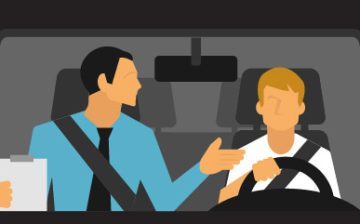Driving is a crucial skill that many individuals acquire to enhance their mobility and independence. However, as the rules of the road evolve and individuals’ driving abilities change over time, there are instances where further education or assessment is necessary. Two options that individuals often encounter are the Driver Education Program and the Re-examination Course. In this article, we’ll delve into the distinctions between these two offerings, their purposes, and what they entail.
Table of Contents
- Introduction
- Driver Education Program: Building the Foundation
- Understanding the Purpose
- Curriculum and Structure
- Benefits of Enrolling
- Re-examination Course: Refreshing and Reassessing
- Why It’s Needed
- Course Content and Format
- Advantages of Participation
- Comparing the Two Programs
- Focus and Intent
- Target Audience
- Duration and Time Commitment
- Which Program Should You Choose?
- Assessing Your Needs
- Considering Driving History
- Personal Goals and Objectives
- The Importance of Ongoing Learning
- Adapting to Changing Regulations
- Enhancing Road Safety Awareness
- Conclusion
- FAQs
Driver Education Program: Building the Foundation
Understanding the Purpose
The Driver Education Program is designed for individuals who are new to the world of driving or are seeking to obtain their first driver’s license. The primary purpose of this program is to provide comprehensive education on the rules, regulations, and skills required to become a responsible and safe driver.
Curriculum and Structure
The curriculum of the Driver Education Program or Adult driver education course covers a wide array of topics, including traffic laws, road signs, defensive driving techniques, and basic vehicle maintenance. The program is typically structured into both classroom sessions and practical driving lessons, ensuring that participants receive a well-rounded understanding of driving concepts.
Benefits of Enrolling
Enrolling in a Driver Education Program offers several benefits. Participants gain a solid foundation of driving knowledge, helping them feel more confident and prepared when navigating various traffic situations. Moreover, insurance companies often offer discounts to individuals who have completed a recognized driver education course.
Re-examination Course: Refreshing and Reassessing
Why It’s Needed
The Re-examination Course, on the other hand, is intended for individuals who have been driving for some time but may need a refresher on updated road rules or specific driving skills. It is also required for those who have received multiple traffic violations or have been involved in accidents due to negligence.
Course Content and Format
This course revisits crucial aspects of driving, such as road signs, right-of-way rules, and defensive driving tactics. It aims to ensure that experienced drivers stay informed about the latest changes in traffic regulations. The format often involves condensed classroom sessions and practical assessments.
Advantages of Participation
Participating in a Re-examination Course can lead to improved driving habits, a clearer understanding of current traffic laws, and a reduced risk of accidents. It also serves as a platform for drivers to address any bad habits they may have developed over the years.
Comparing the Two Programs
Focus and Intent
While both the Driver Education Program and the Re-examination Course revolve around driving education, their focuses differ. The Driver Education Program aims to establish a strong foundation for new drivers, emphasizing the basics of safe driving. The Re-examination Course, on the other hand, concentrates on updating experienced drivers about recent changes and reinforcing safe practices.
Target Audience
The Driver Education Program primarily targets new drivers, typically teenagers or young adults obtaining their first drivers license course online. In contrast, the Re-examination Course caters to individuals of varying ages who have held a driver’s license for an extended period.
Duration and Time Commitment
The Driver Education Program generally spans several weeks, with a combination of classroom sessions and practical lessons. The Re-examination Course is often shorter, focusing on key areas that require updating without the need for an extensive time commitment.
Which Program Should You Choose?
Assessing Your Needs
The choice between the Driver Education Program and the Re-examination Course depends on your individual needs. If you’re a new driver looking to build a strong foundation, the Driver Education Program is the right choice. If you’re an experienced driver seeking to stay current with changing regulations, the Re-examination Course is more suitable.
Considering Driving History
Your driving history also plays a role. If you’ve received traffic violations or been involved in accidents, a Re-examination Course might be mandatory as part of the process to retain your driver’s license.
Personal Goals and Objectives
Consider your personal goals as well. Are you looking to learn from scratch, or do you simply need a refresher? Are you aiming to enhance your driving skills or address specific challenges you’ve faced on the road?
The Importance of Ongoing Learning
Adapting to Changing Regulations
Regardless of whether you choose the Driver Education Program or the Re-examination Course, both highlight the significance of ongoing learning. Traffic laws and regulations evolve, and staying informed is crucial to ensuring your safety and the safety of others on the road.
Enhancing Road Safety Awareness
Participating in either program demonstrates your commitment to being a responsible driver. By doing so, you contribute to creating a safer driving environment for everyone.
Conclusion
In the realm of driving education, the Driver Education Program and the Re-examination Course serve distinct purposes. The former lays the foundation for new drivers, while the latter refreshes and updates experienced drivers. Choosing between the two depends on your specific needs, driving history, and personal objectives.
FAQs
- Is the Driver Education Program only for teenagers? No, while it’s often associated with teenagers, adults who are new to driving can also benefit from the program.
- Can I enroll in the Re-examination Course voluntarily? Absolutely, enrolling voluntarily can help you stay up-to-date with the latest driving regulations.
- Is the Re-examination Course challenging? The difficulty level depends on your existing knowledge and the changes in traffic regulations since you last received driver education.
- Will completing the Re-examination Course remove my traffic violations from record? Completing the course won’t erase past violations but can demonstrate your commitment to improving your driving skills.
- Can I take the Driver Education Program if I already have a license from another state? Yes, the program can be beneficial for understanding the specific driving rules and culture of your new location.









